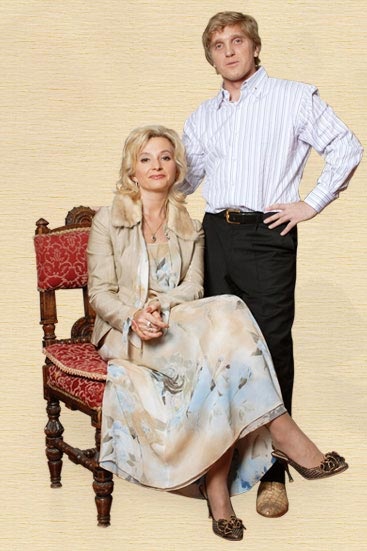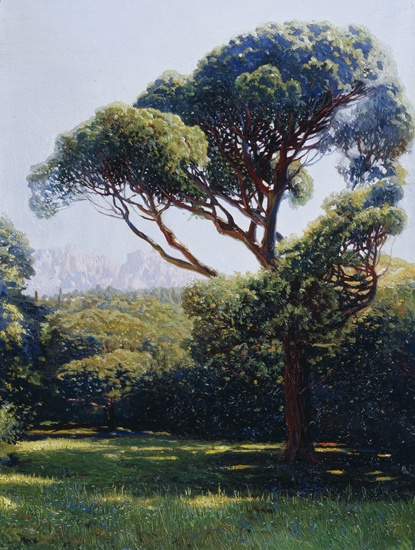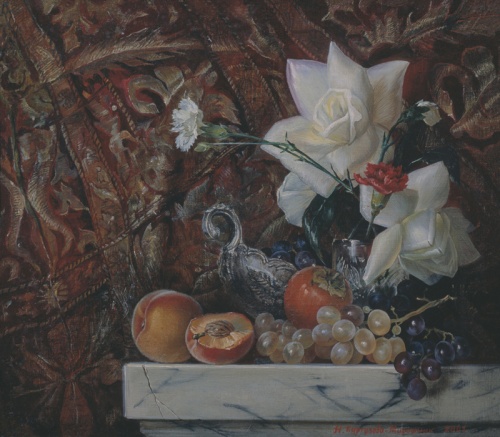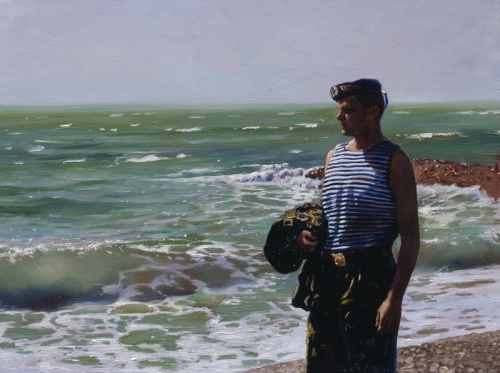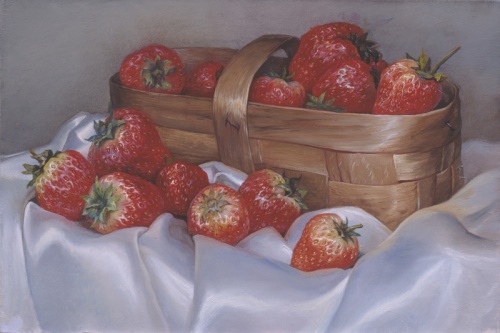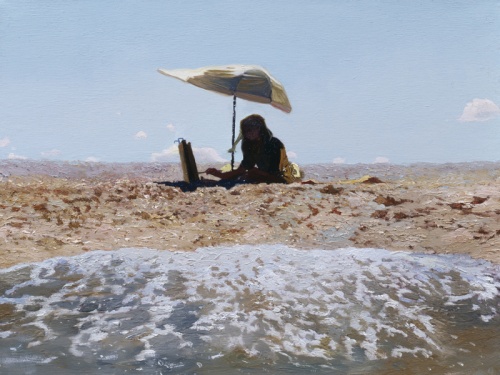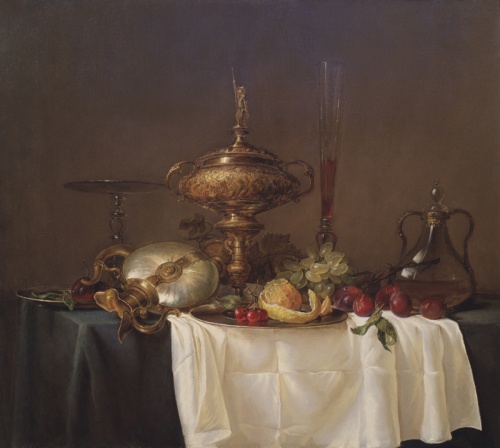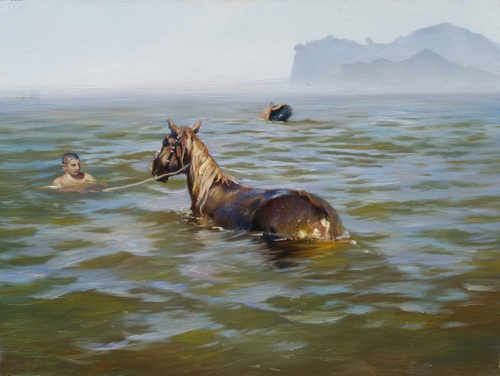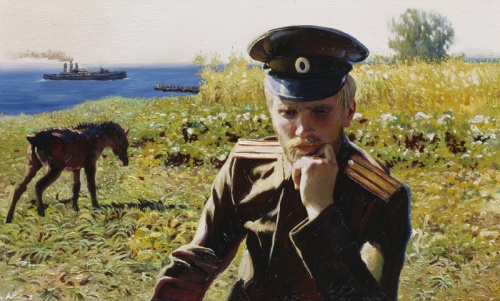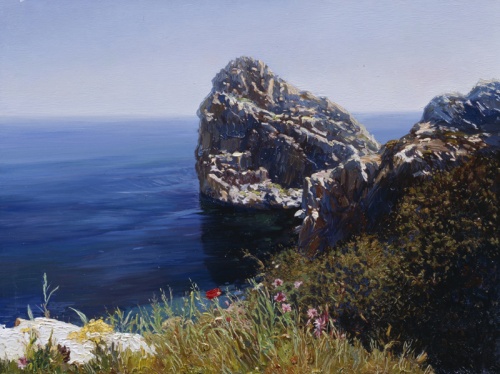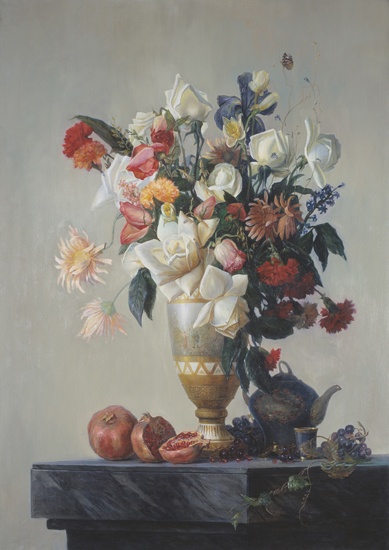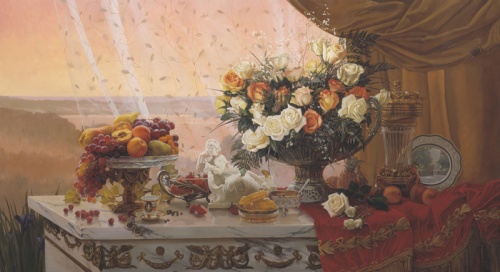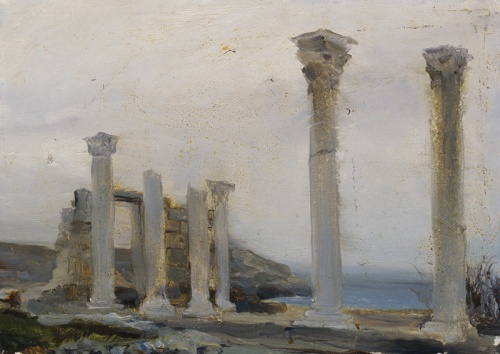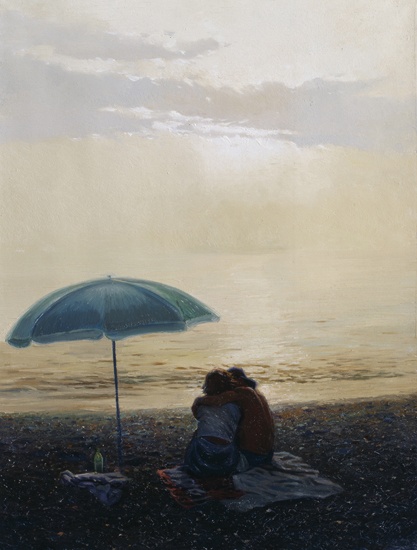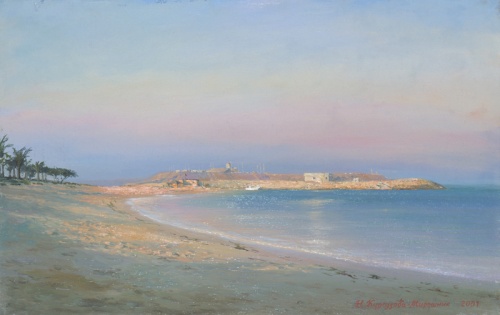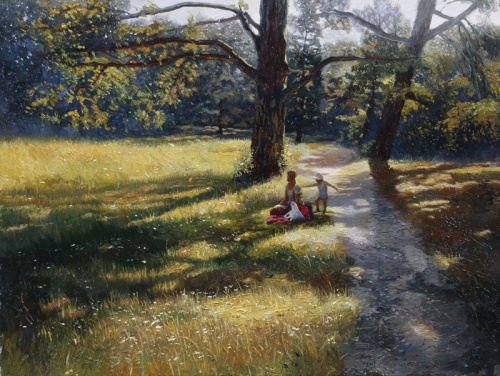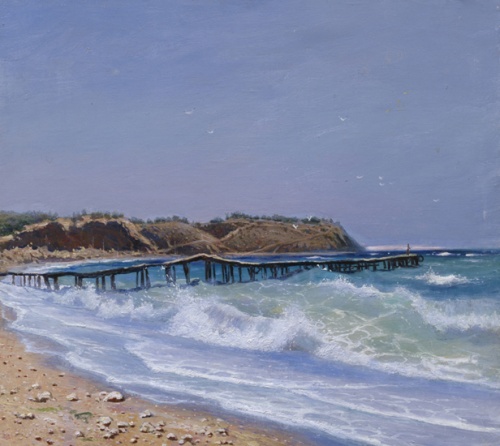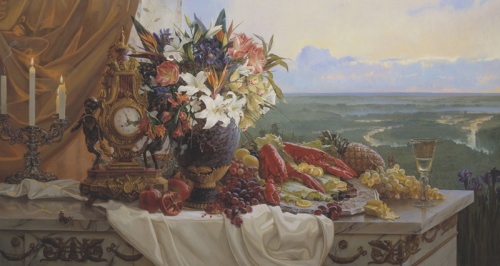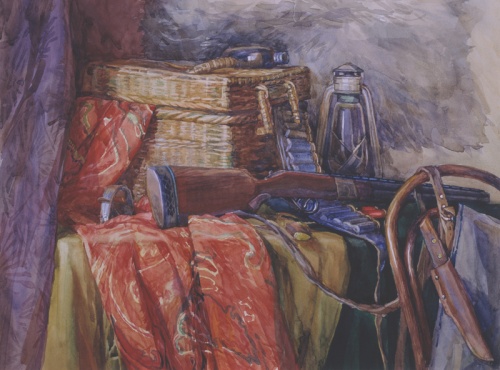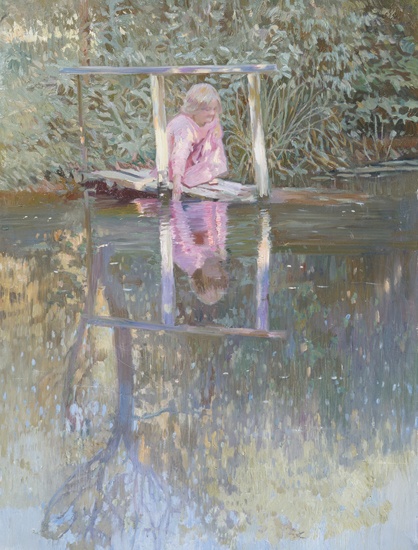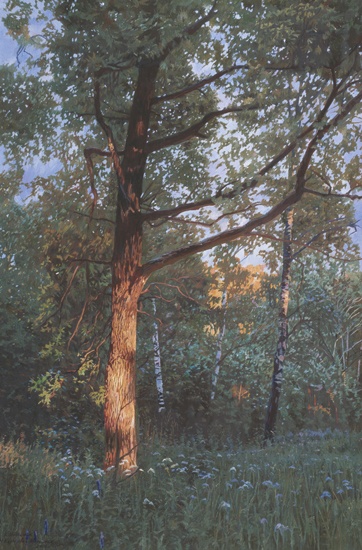Konstantin Miroshnik and Natalya Kurguzova-Miroshnik (continued) (132 works)
Разрешение картинок от 800x205px до 800x1014px
In this solemn atmosphere, Ilya Glazunov, who always demanded initiative and independence in creativity from his students, said reproachfully: “Why didn’t it occur to anyone to paint a picture dedicated to the great Russian poet, for example: “Pushkin takes exams at the Lyceum” - an excellent topic , the picture will turn out good, anyone will buy it from you for a lot of money! This painting would cost a million dollars! And you don’t do anything...”
Students had a hard time with money. Therefore, some decided that perhaps Ilya Sergeevich’s advice would really help them improve their financial situation.
Then everyone went together to the Church of the Sign, built in the first half of the 19th century according to the design of the architect I. Blank. In the church, some of the guys began to consult with Glazunov on what books to read, how to approach the topic, so that a successful work would surely come out. Ilya Sergeevich immediately recommended studying a book dedicated to the life of the great poet, which was sold right there in a nearby stall; the price of the volume turned out to be unaffordable for the students, so the expensive edition was left to wait for another buyer.
Returning to Moscow, all the artists, in order to rehabilitate themselves before the rector, decided to turn to the theme of Pushkin...
And after just a few weeks of intense creative work, one of the most enterprising students walked onto the platform of the Moskovsky Station in St. Petersburg, holding in his hands his future first million dollars - the painting “Pushkin in Tsarskoe Selo”. The artist was almost sure that the masterpiece would be bought “straight from the station,” but this did not happen. The film was successfully delivered to the Tsarskoye Selo Lyceum. The staff of the memorial museum greeted the resourceful artist with bewilderment, although they offered to place the canvas in the interiors of the lyceum, where it hung for four years until the master took it back to Moscow.
During his studies, in 1994, Konstantin Miroshnik took part in an exhibition of works by I.S. Glazunov in the Manege, and already in 1995 a personal exhibition of the master took place in the city of Yuriev-Polsky, which became his home during his studies at the school. The exhibition featured more than a hundred paintings, which evoked admiring and grateful reviews from the audience.
In 1997, Konstantin graduated from the Academy, his diploma work “Old Books” was recognized as the best of the course. The head of the portrait workshop is Professor Leila Samiulovna Khasyanova.
The creation of the canvas was preceded by Constantine's trip to the Trinity-Sergius Lavra to ask in fervent prayer for a blessing to create a new work at the tomb of St. Sergius. Kostya made this journey to fall before the relics of the great prayer book, asking for blessings and help. Many say that in this sacred place deep inner peace and calm determination descend into the soul.
In the Trinity-Sergius Lavra, the young artist was once again able to see the places he loved so much, which were once covered with dense forest and witnessed the solitary prayerful exploits of St. Sergius. Here Kostya’s soul was again overcome by an inexplicable feeling of tenderness.
Then Kostya headed to his beloved Optina Pustyn, which sheltered him and his mother when the young artist entered the Academy.
The image of the young monk in the painting “Old Books” is full of deep concentration and detachment. He is immersed in reading old books and for him this becomes a moment of revelation, communion with the Eternal Truth.
In the picture, the kneeling pose of the novice, the reverent gesture of his hands, the spirituality of his appearance make us understand how reverent and sincere the joy of the young man is, what an unusual excitement gripped him.
The light penetrating from the high window softly falls on the monk’s face, on the pages of open books, and flashes on the red-golden fabric.
The interpretation of the theme of spiritual quest, the moral development of man in the film presupposes subtle psychologism, a certain specification of the situation, and the sincerity of the feelings and experiences of the creator himself. Time seemed to freeze for a moment, only to then continue moving again. The artist embodies his aesthetic ideal, guided by Christian ideas about beauty, which is the highest embodiment of good, and in the concept of an Orthodox person - effective good. The novice is full of inner light in his desire to know God.
In the painting, the image of a book takes on an unusually deep meaning. A book, especially of spiritual content, has always been the main, and sometimes the only, consolation for the hungry and exhausted, serving as a kind of spiritual compensation in difficult periods of life and history. The book, in the words of the famous poet, set “pain to music” and always affirmed the intrinsic value of the human person as a Divine creation, more important than all state laws and forms of organization.
Books contain all the wisdom and all the philosophy of life. A book is an integral component of culture, creating what we call our spiritual world. The spiritual world is the highest form of life, thanks to which people move away from what, in
in essence, is a primitive restoration of physical strength. If people only engage in the fact that, while absorbing products, they work to produce these products - this is the cycle of primitive man. Unfortunately, many people now essentially live like this. Only a few come out of this circle, creating something truly significant in the course of their lives. And people who join them learn that there are higher forms of life, and having learned, they become happy - like people themselves. And in this communion, it is the book that plays an important role; it is the main guide. And indeed, perhaps, not a single area of our spiritual life can compare with what literature can provide - spiritual, artistic, historical.
The book teaches you to recognize the greatness of human existence. It is inextricably linked with culture, our social image, whatever it may be - sad or optimistic.
The genre diversity of the artist’s painting comes from the life position of the artist himself, who believes that one cannot isolate oneself in oneself, on one’s purely personal experiences, one must constantly strive for moral perfection, for divine harmony. Therefore, for Konstantin Miroshnik, turning to gospel subjects, or subjects of deeply religious content, is not accidental.
Another serious stage in Konstantin’s work is the creation of the painting “Battleship Potemkin” (1998). This painting is dedicated to the tragic events of the Russian-Japanese War. This heroic page in the history of the Russian fleet was turned over on the morning of May 15, 1905.
The atmosphere of a naval battle is conveyed by the artist with a sense of admiration and pride. Flashes from shell explosions stand out brightly against the background of the blackening swell. The contrast in color enhances the feeling of mortal danger hanging over the sailors. True, wars are not reduced by Konstantin Miroshnik to naked naturalism, which is quite in the traditions of the Russian battle genre: before us is not a dispassionate chronicle, but a difficult moment of the death of a Russian ship, experienced with all our souls.
Over time, Natalya and Konstantin leave the kindergarten that sheltered them and move to live in Lyubertsy. So the small apartment on the ground floor becomes their new home and new workshop. The artists say that the dwelling was small, damp and uncomfortable; they jokingly called it a basement. There were mice in the apartment that were impossible to get rid of - no methods helped, it got to the point that Kostya caught them by the tail and threw them out the window.
It is here in Lyubertsy that artists meet Alexander Barykin. One morning, standing at the open window, Miroshnik saw a man passing by with a hat pulled down over his eyes and a dog on a leash. Kostya immediately recognized the famous composer, since he had long loved his work. The artist went out into the street, called out to Barykin, and fifteen minutes later they were sitting in the Miroshnikovs’ house and talking over a cup of tea, like old friends.
This is how their acquaintance began. From that day on, Barykin knocked on the window of Natalia and Konstantin’s apartment almost every day at 8 o’clock in the morning, and then, sitting on their couch, wrote songs and took painting lessons. Thanks to conversations between friends, new themes for paintings and new musical compositions were born.
The friendship between the composer and the artist turned out to be mutually enriching and fruitful. Alexander Barykin became interested in fine arts and began creating paintings. And Konstantin, who has been seriously involved in music for a long time, thanks to the production center of A. Barykin, released a CD with recordings of his songs.
Natalia and Konstantin are unusual artists. They create all their paintings in collaboration. The artists admit that working together is both interesting and fruitful for them. When two creative people are constantly involved in the process, there is no danger that someone will run out of steam halfway through, or cool down on the topic, because, as painters say: “co-authorship is a constant dialogue, sometimes an argument, a search for new solutions to set painting tasks, this is definition cannot be boring.”
Konstantin and Natalia successfully participate in a large number of exhibitions, articles are published about them, reproductions of the artists’ works are published in many catalogues, the White City publishing house has published a monograph dedicated to the work of young masters.
The exhibitions held in 2002 at the Volzhsky Automobile Plant and at the Palace of Culture and Technology of JSC AVTOVAZ were an incredible success.
Natalia and Konstantin showed the audience more than seventy works. The exhibition includes all the best works of the authors - paintings on religious and historical themes, landscapes, portraits, still lifes.
To this first major exhibition, artists brought their monumental canvases depicting Vladimir Monomakh, Patriarch Tikhon, landscapes with the beauties of Russian nature, and churches. All these things carry the idea of unifying Rus', returning to spiritual roots. The exhibition perfectly demonstrated the creative credo of the authors: “to strive for the revival of Russian realistic painting, to glorify in colors the history and culture of the Russian people.” It was during this
bets, young artists included in their creative plans the creation of a series of paintings dedicated to the Volga expanses. And this is not surprising, since the Volga has always inspired masters of the brush: in the second half of the 19th century, the Itinerant artists Ilya Repin, Vasily Surikov, Ivan Shishkin, Isaac Levitan and many others worked here.
One of the visitors left the following words in the guest book: “The AVTOVAZ building often hosts exhibitions, but I have never seen anything like it before. It is deeply joyful and pleasant to contemplate the result of the work of people of truly high talent, talent from God, who, despite our troubled and opportunistic times, continue to talk about beauty and sublime feelings. In these paintings I saw everything that can excite the heart of a Russian person, I saw the Motherland.”
One after another, exhibitions are held in Samara, Novokuybyshevsk, and in the Moscow State Duma.
An interesting incident occurred during the artists’ stay in Dubai (UAE). During the entire rest, Natalia and Konstantin, invariably at six o’clock in the morning, went to sketches and worked almost all day long, so after twenty days they managed to write more than fifty works. The management of the hotel where the artists lived, seeing their amazing works, proposed organizing an exhibition. The masters happily agreed. The success surpassed all revivals; Natalia and Konstantin were literally begged to stay in the country, they promised to provide all the conditions and opportunities for artists to work in Dubai.
A real event in the cultural life of the capital was the personal exhibition of Konstantin and Natalia, “High Realism,” held in the New Manege in 2007. This event took place, largely thanks to the help of State Duma deputy Konstantin Zatulin, who personally sent a request to the Ministry of Culture.
In organizing the exhibition, the Miroshniks were helped by friends, acquaintances, and admirers of the artists’ talent; family friend, poet and art admirer Ivan Ivanovich Pereverzin helped frame many of the works.
Young artists always say: “The greatest reward for a master is the attention paid to his works.” And the exhibition at the New Manege demonstrated the attention of the sophisticated Moscow public to the art of the Miroshnikovs. The guest books are evidence that the audience not only recognized the high professionalism and undeniable talent of Natalia and Konstantin, but also sincerely fell in love with the work of the young masters.
A PICTURE HYMN TO NATURE
Konstantin and Natalia are artists of unusually high talent, searching, constantly improving, despite their youth, they have already become classics in their format. Their creative thought is close and understandable to modern people; their art is capable of not only giving the viewer wonderful emotions, but also successfully serving to foster love for their native land. Today they are writing a new, intimate page in the history of Russian fine art, filled with a poetic vision of the world, and creating a picturesque hymn to the nature of Russia.
Extremely interesting is a series of works dating back to 2001, created as a result of Miroshnikov’s trip to the United Arab Emirates.
In Dubai, artists never left their brushes for a moment. Everything that surrounded them every day became the subject of sketches. The result of a twenty-day rest was the creation of more than fifty sketches. The exotic and pristine nature of the East in the paintings of Natalia and Konstantin literally captivates the viewer. This series of sketches reveals to us a unique, mysterious and beautiful world that has fascinated artists.
THE SKY IS CLEAR AS JOY...
Nowhere, probably, does the earth smell as pungently as in Crimea. Nowhere else is there such air, heated by the sun, saturated with the intoxicating aromas of herbs. And the sky, about which Pushkin said: “...pure, like joy.”
The artist, philosopher and poet Maximilian Voloshin, who dedicated many piercing lines to this region, argued that the landscape of Crimea is completely special - elusive, changeable, fluid, like hot desert sand.
One of the brightest pages in Miroshnikov’s work are works dedicated to Crimea. The Crimean series is a thematic series of works, the predominant place in which is occupied by paintings and sketches depicting amazingly beautiful sea views. No less interesting are the landscapes that depict the expanses of Ukraine, the homeland of Konstantin Miroshnik.
Konstantin, being fascinated by the landscapes of Crimea, studying the work of such outstanding marine painters as I. Aivazovsky, L. Lagorio, A. Fesler, nevertheless, was always convinced of the need to find his own path. The success of the artist’s Crimean works was predetermined by creative rethinking
An important quality of the master’s landscapes is their musicality. And this is not surprising, because the artist writes songs and plays the guitar. It is possible that this is the secret of the soft lyricism of his Ukrainian landscapes. They contain a sad beauty that touches the soul, a melodious quality that can be heard in drawn-out Ukrainian songs.
Miroo
Constantine’s feeling is romantic, and therefore the seething energy of the sea element is akin to the artist’s soul - searching, irrepressible, restless in the best sense of the word. The precise pictorial language surprisingly accurately conveys the movement of the wave, accompanied by seagulls, rushing indomitably towards the shore. The ever-changing sea attracts and fascinates. A well-thought-out composition in a painting helps to avoid descriptiveness; the viewer’s gaze immediately covers the entire image. The major color evokes in the viewer both delight and intoxication with the endless silver-blue expanse of the sea.
The creative path that Konstantin and Natalia follow hand in hand combines an appeal to a variety of themes and motives. And along with exquisite and spectacular seascapes, artists transfer onto canvas views of ordinary farms and villages, with their lowlands and steep slopes, endless, sun-scorched steppe expanses, bearing the signs of childhood and youthful memories of Konstantin Miroshnik.
The most favorite time of year for Konstantin is summer, and one of his favorite motifs is the sun.
ABUNDANCE OF EARTHLY GOOD
The consciousness of ancient people endowed the world of objects with human properties, spiritualized the material, and humanized the inhuman. In European art, this gave rise to the emergence of a special genre dedicated to the life of things - still life.
In a still life, things are not just depicted on the canvas, they live, speak, communicate with each other and with us, the audience. In a still life, the thing is larger than itself, since the artist treats Being as a special value, and this is transmitted to the viewer in the process of communicating with the work.
Communication with a work of art is always a dialogue between the author and the viewer. A work of art is interesting because, with the help of the artist, the character reveals his soul, inviting us to a reciprocal confession. A painting can express with color, line, and rhythm what is beyond speech. Her silent word, intended for the eyes, speaks no less eloquently than the word addressed to the ear.
In Holland this genre was called stilleven, which means “quiet life”, but everyone is more familiar with the word “still life” - “dead nature”.
Dutch painters created still lifes with an almost unchanged composition. They are usually called "desserts" or "breakfasts". The first stillevens are simple - bread, a glass of wine, fruit, fish. But all the objects in them are symbolic: the fish is a symbol of Jesus Christ; the knife is a symbol of sacrifice; lemon is a symbol of unquenched thirst; a few nuts in the shell - a soul bound by sin; the apple reminds of the Fall; wine or grapes are a symbol of Blood; bread is a symbol of the Flesh of Christ. This is a remembrance of the Last Supper, which gives life, this is a sermon about salvation.
Gradually, the still lifes began to be filled with earthly wealth: carpet tablecloths, silver goblets, mother-of-pearl. Simple food was replaced by oysters, ham, and exotic fruits. Painted with magnificent materiality, the canvas spoke of the futility of human life, of sinful love for earthly wealth. There are still lifes where a glass falls, wine spills - the world wins. So in the Dutch stilleven there appears a memory of another meal - the feast of Belshazzar, leading to death.
For Konstantin Miroshnik and Natalia Kurguzova-Miroshnik, still life is not only an opportunity to pay tribute to Dutch, Flemish and Russian art, the skill of the Pre-Raphaelites, but it is also a genre in which artists seem to let through themselves the color-saturated and luminous beauty of the objective world, inspired by man , generosity and diversity of nature's gifts.
When creating her still lifes, Natalia proceeds, first of all, from the decorative properties of the objects themselves. She groups them on the canvas, starting from the natural color, shape and texture of utensils, fruits, and draperies. The artist seems to create a still life twice: first in real space, thinking through all the details of the composition, choosing angles, and then on canvas.
Thanks to the desire to capture the fragile life of the so-called “inanimate” nature, the desire to convey their own, poetic, perception of the beauty of the objective world as an integral part of human existence, Konstantin and Natalia co-created many amazingly beautiful still lifes.
Artists introduce another important feature into their still lifes - the life of things in their works is always connected with the life of a person. The invisible human presence is felt in everything: in a peeled apple, in a cut lemon rind, and in an overturned glass of wine.
Being virtuoso masters and playwrights in painting, Natalia and Konstantin skillfully create not only the impression of materiality and sculptural plasticity, but also know how to convey the awe of the life of the depicted objects. To enhance this effect in many paintings, artists miraculously revive “dead nature” by introducing into the compositions images of living creatures - butterflies, bees, dragonflies, birds, snails.
A profound love for nature, for all its manifestations, even its most insignificant, and a reverent attitude to detail allows artists to turn all objects literally into works
jewelry art.
THE ART OF SEEING THE SOUL
Konstantin and Natalia are rightfully considered not only brilliant masters of painting and drawing, relying in their work on the best traditions of Russian art, but also subtle psychologists who can see the world with amazing accuracy. That is why their work is distinguished by a direct, unusually heartfelt and lively reaction to nature, to the model, and to life itself.
A special page in the work of artists is the portrait. In each new work, Natalia and Konstantin discover new facets of beauty and unique charm in their models. The vision of the masters is so deep and accurate that sometimes the result of joint work becomes an interesting and unexpected discovery for the subjects themselves.
The portraits created by Konstantin and Natalia are portrait-paintings, their task is not only to immaculately correctly reproduce the appearance of the model on canvas, but also to embody in paint the entire abyss of the human personality - incomprehensible and inimitable.
One of the themes of the artists’ creativity is the exaltation of man, admiration for his natural strength and beauty given by God. Integrity, persuasiveness and psychological depth of portrait images become possible thanks to a thoughtful, attentive attitude to the external appearance of a person, his internal state, and the disclosure of all character traits.
The work “Homeless” is characterized by the artist’s characteristic expressiveness of type and high pictorial skill.
When looking at this work, the viewer may experience some confusion: on the canvas we see the image of a clergyman, and the work is called “Homeless”. This is due to the fact that Natalia chose a homeless man as a model for the portrait. The artists, wanting to help the homeless man, invited him to the studio to work as a model.
Natasha says that she was struck by the tragic fate of this man: on May 10, at that time, a respected and prosperous man, who had two higher educations, a good job and a family, accidentally ran over a foreigner’s dog that ran out onto the road, the rules in the country were harsh at that time, the man was put in prison, his wife left, his property was confiscated. So an absurd incident instantly changed a person’s life, fate was broken.
During one of the classes, the famous artist Alexander Shilov came into the workshop of the young painters who were painting a homeless man; at that time he was teaching at the Academy. At that moment, the students witnessed a silent scene - Shilov recognized in the now homeless man his good school friend, with whom he sat at the same desk.
In the face of a simple homeless man, Natalia was able to see an unusually noble type, an appearance full of dignity with a deep and wise look. The picture contains the deepest meaning and reveals the true tragedy of human existence, devastated by the cruel social conditions of life. We see inner drama in everything: in monochrome color, dim lighting, the tired but stubborn look of the person being portrayed, in the knitted overhanging eyebrows. The sharpened psychological characteristics contained in the details evoke in the viewer a feeling of homelessness and loneliness of a person who has experienced need and deprivation. This is an artificially created image of a priest, but the talent of the master and the power of true art make him unusually truthful and heartfelt.
The portraits created by Natalia Kurguzova-Miroshnik and Konstantin Miroshnik are undoubtedly distinguished by their ability to deeply perceive a person’s individuality and the ability to make this individuality tangible for viewers. Painters do not strive to create portraits in the narrow sense of the word. They manage to achieve a generalized image, genuine artistic typification, thanks to which the works of the masters make such a strong impression on their contemporaries. Natalia and Konstantin, due to their artistic gift, are able to talentedly lift any image above the prosaic everyday life, and say the best words about their model in colors.
LOVE MADE VISIBLE
Among the many varieties of the portrait genre, the most complex, but perhaps the most interesting, is the children's portrait.
For Konstantin Miroshnik and Natalia Kurguzova-Miroshnik, children's portraits are one of their favorite subjects. And the impetus for this was the birth of my own child.
Natalia and Konstantin successfully managed to find surprisingly subtle, sensitive and soulful visual means and ways of reflecting the world of childhood. The children's images in their paintings are endowed with an indescribable originality and psychologism inherent in the best masters of children's portraits.
How soft and lyrical the image of the girl is captured on canvas, how much calm and homely trust there is here. The viewer does not see any internal conflict, but only a cozy and caressing world of an inspired children's paradise, the naive and trusting life of a child. This work is full of that inner fire that captivates the audience at first sight. Looking at this portrait, I want to thank God many times over for
the fact that He is so generous that He gives a person this wonderful period of life - childhood. A carefree time filled with magic, sun and joy. When you can be sincerely surprised by everything, when everything is for the first time, and every new day invariably brings so many incomprehensible and unusual things that it takes your breath away.
Artists always notice the liveliness and restlessness of children, but treat them seriously, thoughtfully, comprehending the movement of the child’s soul. In their works one can clearly read the presence of the concept of the intrinsic value of childhood as a special happy time in life. The thoughtful, capricious, enthusiastic, laughing faces of boys and girls look at us from the portraits. They, too, will someday grow out of their lovely lace dresses, forget about dolls and their favorite teddy bears, and enter a completely different life - an adult. But this will happen a little later. And now these angelic eyes look at us as they can look only in childhood, into the very soul - trustingly and openly. And the words of the classic always come to mind: “children are love made visible.”
HEROICS AND TRIVILESS OF WAR
In their art, Natalia and Konstantin strive for a combination of two artistic movements - academicism and impressionism. Impressionism is synonymous with color and freshness of painting, and for academicism, the decisive factor is the skill of execution and the professional skills of the creator. It is difficult to harmonize these principles. If the artist overdescribes objects, naturalness and lightness disappear from the painting, but if the details are not worked out enough, the image on the canvas gives the impression of an unfinished work, a sketch. According to artists, when working on a painting, it is important to professionally solve these painting problems, since it is thanks to the harmonious consonance of the basic principles of academicism and impressionism that a canvas made in the spirit of high realism is born.
Another important creative principle for Natalia and Konstantin is the presence of a theme in the picture. Ilya Glazunov often says that a significant drawback in modern art is the reluctance of young artists to raise deep and pressing problems of our reality in their paintings; many masters neglect such a concept as a theme and paint pictures about nothing.
One of the important milestones in Miroshnikov’s work is a series of canvases dedicated to the theme of the Great Patriotic War. In such works, artists strive to combine the emotionality and semantic depth of the picture with the skill of execution.
Many masters addressed the theme of the Second World War. Konstantin and Natalia offer their interpretation of the tragic events of that time, their paintings are at the same time reflections on the tragic periods of history and a tribute to the heroes and victims of the war, a desire to ensure that contemporaries do not forget about the great feat of their fathers and grandfathers.
Art knows how to absorb the best and most important thoughts, to capture the spiritual movements of its time. It alone expresses the most complex shades and conveys all the signs of a person’s internal and external appearance.
The pictorial power and artistic fullness of the painting are aimed at creating, through visual images, through the mood that color and rhythm convey to us, a hymn to the captivating beauty and eternal power of art, which, despite destructive wars and disasters, but thanks to its undying power of influence on people has the rare ability to gain eternal life.
In a series of paintings dedicated to the Second World War, Miroshniki appears to us as thinking and empathetic artists, with a passionate temperament. Each of their paintings carries a life-affirming principle and strives to convey to the viewer a feeling of reverence for the feat of our fathers and grandfathers.
No matter what topic Konstantin Miroshnik and Natalia Kurguzova-Miroshnik encounter in their work, their appeal to truth permeates their work with the light of kindness, a feeling of great, boundless harmony of the world.
Borisova Marina,
art critic
